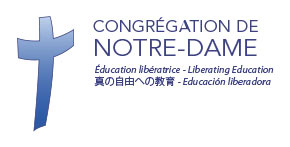The stable-school, the first school in Ville-Marie and first Mother House of the Congregation (1658-1671), was situated between present day Saint-Paul Street and the Saint Lawrence River. This illustration was imagined by the artist from the description made by Marguerite Bourgeoys in her writings.
Sister Patricia Simpson points out that in the beginning the Sisters of the Congrégation de Notre-Dame were dressed like all the other women of the 17th century. They wore a black dress, a kerchief over their shoulders and a scarf covering their head and knotted under the chin. The only distinctive element was the cross.
The habit we see here was worn until 1965 when it was modified. The parts that correspond to the original form of dress are the pleated skirt and the cincture. In the 19th century, the sisters began to starch and stiffen the kerchief, which until then had been soft. The scarf, at first used to cover the head, was lengthened, becoming a veil.
The cornet, very specific to the Congrégation de Notre-Dame, was made from a single piece of starched linen that was folded to frame the face. Two pieces of cardboard or wood were inserted in the side folds in order to maintain the shape of the cornet. At the top, a pin was inserted to form the characteristic peak. The linen was folded under the chin and secured with several pins. The cornet was attached to a headband worn around the head under a black cap and the veil.
Sister Rolande Savoie speaks about the history of the Bureau des Études of the Congrégation de Notre-Dame and outlines some of its activities.
Sister Savoie mentions that it was at the request of the Bishop of Montreal, Bishop Bourget, that the Congregation created, in 1857, its Bureau des Études which was first entrusted to Mother Saint-Victor.
The personnel of the Bureau des Études had many responsibilities. They had to visit all the houses in the provinces and then write a report on each house and each professor, both religious and lay, and submit it to the Congregation Leader and her council. The Bureau also approved exams for the primary and secondary schools, the arts-sciences courses and the business courses.
She also talks about the period when the Sisters of the Congregation followed government requirements to obtain a teaching permit from the State. The Bureau supervised this undertaking.
Sister Savoie points out that in 1985, when the Mother House of the Congregation moved from its Sherbrooke Street location to the former Institut Pédagogique on Westmount Avenue, it was the Bureau personnel who took on the task of reducing the library content by offering books to the Mother House employees.
She concludes by adding that the school archives of the Congregation are now, in part, at the current Mother House and, in part, at the Marguerite-Bourgeoys Province Administrative Centre. Sister Béatrice Granger manages this department.
Shortly after Marguerite Bourgeoyss death, Pierre Le Ber painted this painting, the only true representation of the foundress of the Congrégation de Notre-Dame. From the mid 19th to the beginning of the 20th century, the work went through several modifications. Among them, was a complete over-painting to soften the aesthetic traits which did not correspond to the tastes of the time. The restoration work of 1963 and 1964 revealed the original portrait which dated back to 1700.
Étienne Montgolfier was born on December 24, 1712 in Vidalon (France). Ordained priest in the Compagnie de Saint-Sulpice in 1741, he came to Montreal in 1751. He was appointed Superior of the Sulpicians in 1759, but his term in office was made difficult because of the British conquest. He was Vicar General of the Bishop of Quebec, Msgr. Jean-Olivier Briand, and also chaplain of the Congrégation de Notre-Dame. He participated in the reconstruction of Notre-Dame-de-Bon-Secours Chapel, which had been destroyed by fire in 1775 and wrote La vie de la vénérable sur Marguerite Bourgeois published in 1818. In 1787, he retired from his charge as Superior of the Sulpicians and Vicar General. He died in Montreal on August 27, 1791.
Merit points in the form of pretend coins or coupons made of cardboard or printed paper were used to reward the students for their good deeds. They were given out by the teacher to encourage the students who had worked well. However, they were taken away when they did not behave properly. These points were exchanged for a gift, at the time it was often a holy picture
